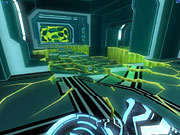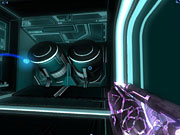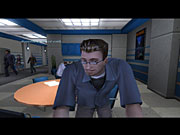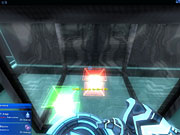The 1982 film Tron may not hold up by today's standards, but it was a revelation for anyone who grew up during the video game boom of the early '80s. The movie was filled with vivid computer-generated graphics, and it put the lead character first in a real arcade and then in neon-lit cyberspace, where anthropomorphic "programs" faced off in video-game-style challenges. For young gamers, at the time, watching Tron was like dying and going to cinematic heaven. Tron gave birth to some fun games back in the day, and now Monolith brings you Tron 2.0 for the PC. Like the film, Tron 2.0 treads a fine line between cool and corny, and, also like the film, it often stumbles into the latter. Like the movie, the game also boasts a unique visual style. However, despite its great look and some exciting moments, Tron 2.0 is a fairly conventional and uneven shooter.
Tron 2.0 picks up where the film left off. After years of research, programmer Alan Bradley has finally managed to re-create the technology needed to digitize humans and send them into and out of the digital/virtual world. A big, bad corporate rival, Future Control Industries (or fCon) is after Bradley's research and is about to take over his company. When Bradley's AI creation, Ma3a, comes under attack and Bradley suddenly disappears, his son Jet must save the day. After Jet is conveniently digitized, it's off to the races in a thematic and visual retread of the film: Basically, red security programs menace Jet, lots of deadly discs get thrown about, a sexy female program helps our hero escape from the light cycle grid, and so on.
While staying true to the film, Monolith has ably fleshed out the world of Tron with new allies and enemies. Things are a little more complex than in the movie since there are multiple enemy factions to deal with now. You'll face off against the Intrusion Countermeasure Programs, or ICPs, who are like the red guards of the film. These ICPs aren't particularly bright or deadly, but they usually have numbers on their side. They're under the command of the militant program "Kernel". You'll also have to deal with finders, little sentinels that float around high-security areas and blast you with energy bolts.
Along with these security programs, you'll also have to face a whole other faction of enemies. They are led by the malevolent Thorne, who secretly sold the digitization technology to rival fCon and now acts as head of security for Bradley's company. To prove that the technology actually worked, he tried to digitize himself into the virtual world, but things went awry; he ended up corrupting his data and turning mad. Now a blight of data corruption cascades through the computer world, giving rise to enemies like the Z-lots and rector scripts.
In addition to these corrupted programs, you'll run into game bots, the programs you face in light cycle competitions for the amusement of other programs. More ominous are the resources hogs, pudgy enemies who try to co-opt other programs for their own ends. Then there are the mysterious data wraiths, who are digitized human hackers doing fCon's corporate dirty work from the inside.
While all these enemies sound diverse and interesting on paper, they leave something to be desired in practice. That's because, at heart, Tron 2.0 is a standard run-and-gun shooter with a neon patina. These strange-sounding digital enemies aren't really strange but turn out to be generic cannon fodder. They might engage in idle banter or cry out for help, but otherwise they pretty much just run around and shoot at you.

At the same time, you pretty much just run around and shoot at them in very conventional firefights. The famous glowing, Frisbee-style disc weapon from the movie reappears in a slightly different guise, but it's one of the game's surprising letdowns. It flies and returns to your hands so quickly that it feels more like some fancy machine gun than a specialized, graceful weapon. You can very slightly control the disc in-flight, and you can more or less block with it, but there's just nothing exciting about it and not much finesse required to use it.
In addition to the disc, you also pick up a few other basic weapons during your adventures, but these are equally ordinary at heart. There's a glowing assault rifle, a glowing rod for close combat and sneak attacks, and a glowing ball that acts as a grenade. (Everything glows in Tron 2.0.) Then there are specialized variants like a sniper rifle, which features a really neat animation when you break it out, yet it works just like any shooter's sniper rifle.
Ultimately, the weapons and enemies are basically the same things shooter fans have seen many times over. It doesn't help that the story and characters are forgettable and the dialogue is awkwardly juvenile, with weak humor that mostly falls flat. This is very surprising, given the sharp writing Monolith is known for. Once you look past the unique visual style of the game, you quickly see that many of the levels are bland and linear. You run across a bridge to get to point X to push a button. You hunt for some keys, push some more buttons, meet a forgettable female ally, only minimally interact with the world, and only, occasionally, talk with characters at certain selected junctures. ("Talking" here means listening to some preset dialogue.)
Still, the levels are nicely crafted for what they are and provide a fair amount of action, though the combat is usually bland--a major problem for a shooter. Some memorable moments do enliven things. For instance, when a system-wide reformat, in the form of a moving wall of red energy, threatens to erase you, things perk up. Think of the Star Wars trash compactor scene but on a much grander scale. There's also an exciting shootout on a huge transport ship filled with innocent passengers. The whole ending sequence is wonderfully paced and filled with wild and unexpected visuals.
Just when things get interesting, though, the game typically gives you another forgettable level, or it sabotages itself with unimaginatively implemented shooter clichés. You're forced to protect a helpless ally from hordes of onrushing enemies. You must fight through nonsensical, prosaic boss battles. You have to work through tedious and arbitrary jumping puzzles that require a bunch of retries. These sorts of things can work if they're given a fresh twist, but that's just not the case here.
While the gameplay is mostly generic shooter fare at heart, everything has been given a fresh name. In Tron 2.0, ordinary shooter objects, enemies, and concepts get names inspired by the world of computer programming. A key is now a "permission," an exit is a "data stream," and a power-up is a "subroutine."
The game features light RPG elements, so instead of leveling up, you "upgrade" your character by completing missions and picking up "build notes" that are scattered about the gameworld. Instead of reaching character level two, for instance, you upgrade to version 2.0.0 and get to distribute extra stat points to a handful of abilities like "transfer_rate" (how fast you can pick up keys, power-ups, and the like). As the game progresses, you find, keep, and then upgrade a variety of subroutine power-ups. When installed, these grant you special abilities, like added damage, quieter movement, or higher jumping. You only get a limited number of free "memory blocks," so you need to decide which subroutines to install at any given time.
This whole management aspect of the game adds a welcome bit of strategizing, but it's also where all the computerese moves from being a clever movie tie-in to being potentially frustrating. Figuring out what all these power-ups are and how to manipulate them can be confusing at first because of the cognitive dissonance caused by all the usual shooter terms being switched into Tron-speak. On the bright side, the actual interface for using them is clear once you get the hang of it.
Along with Tron 2.0's story-based campaign, you get a separate light cycle game mode. (You also ride the cycles a number of times in the campaign.) Here you compete in a series of battles against AI opponents in different arenas. For anyone who's seen the film, the cycle racing works just the way you'd expect, with some additions like power-ups, an advanced super cycle, zones that affect your speed as you travel over them, and so forth. If you're unfamiliar with the film, think of the omnipresent Snake game found on cell phones for an analogy. The cycles make 90-degree turns. They can speed up or slow down but can never stop, and each of them leaves a long, receding trail. If you hit a wall, your own trail, or someone else's trail, you lose. So, at high speeds, you try to block in your opponents while avoiding the same fate. The light cycle racing is moderately amusing, with enough variations to keep it interesting for a while. Unfortunately, it lacks the cinematic drama and adrenaline-pumping thrills of the cycle sequence in the film.
You can also race the light cycles against friends, but you'll need a LAN to do it. Internet multiplayer is limited to a disc combat mode, akin to what you see in the film and the old Discs of Tron arcade game. Unfortunately, we were unable to connect to servers to test it. The manual mentions a patch that might address this issue, but it hasn't been released yet. We assume the patch will fix this problem in short order.

More than anything, the Tron film was famed for its then-cutting-edge, computer-generated visuals and trademark neon glow. That's one thing Tron 2.0 nails beautifully. It's all here: the stark, blocky geometric structures outlined in brilliant blues and reds and yellows, the paper-thin trails of the light cycles, and the pulsating diamond-like bytes and bits that occasionally talk to you. As far as copying the film's look and feel, Monolith's artists got it all right. They did have some help from legendary visual conceptualist Syd Mead, who worked on the film and helped design the super cycle for the game. Still, with a few very impressive exceptions, all the blocky, glowing rooms blur together once the neon novelty wears off.
Tron 2.0's audio also fares pretty well overall. Despite having a few well-known actors on board, like Bruce Boxleitner from the film, most of the voice-overs sound generic. In fact, Jet sounds way too much like a gee-whiz Saturday morning cartoon character to take seriously. On the other hand, springy footsteps, derezzing enemies, light cycle engine whines, and weapon effects are all well-done and will be familiar to fans of the film. The music effectively reworks some of the themes from Wendy Carlos' original movie score in a nice homage.
Like the original film, Tron 2.0 has an unusual visual style, though this time it's merely a copy--albeit a very good one--of what was once so fresh and original. The gameplay concepts tie into the film nicely, too, so hardcore fans of the movie should enjoy it as a nostalgic trip. On the other hand, Tron 2.0 suffers from too many generic and uninspired sections and dull combat. The multiplayer issues are also cause for real concern, though we assume they'll be fixed soon enough. Despite such faults, Tron 2.0 nevertheless does have some real strengths that help make it a solid, if ultimately unexceptional, shooter.

